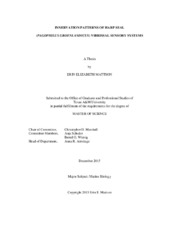| dc.description.abstract | Vibrissae, or whiskers, are largest among pinnipeds and are specialized hairs that potentially evolved to serve sensory, thermoregulatory or protective functions. Behavioral data from pinniped and rodent vibrissa studies indicate that functional differences exist between medial microvibrissae and lateral macrovibrissae. However, comparative data are lacking, and current pinniped studies only focus on the largest ventrolateral macrovibrissae. Consequently, we investigated the medial-to-lateral innervation and microanatomy of harp seal (Pagophilus groenlandicus) vibrissal Follicle-Sinus Complexes (F-SCs). F-SCs were sectioned either longitudinally or in cross-section. Sections remained unstained or were stained with a modified Bodian silver stain (innervation) or Masson’s trichrome stain (microanatomy). Harp seals possessed 88-105 F-SCs and each exhibited a tripartite blood organization system. Hair shafts were more circular medially but became more elliptical laterally. Medial F-SCs had more symmetrical dermal capsule thicknesses and distributions of major branches of the deep vibrissal nerve, but these symmetries diminished as F-SCs became more lateral. Medial-to-lateral axon counts ranged from 550 ± 97.4 axons/F-SC (medial) to 1632 ± 173.2 axons/F-SC (lateral). Overall, axon counts averaged 1221 ± 422.3 axons/F-SC (n=146 cross-sections), indicating a total of 117,235 axons/snout. Lateral F-SCs alone possessed a mean of 1533 ± 192.9 axons (n=82 cross-sections), which is similar to counts reported in other pinniped vibrissal innervation studies. These data suggest that conventional studies that only examine lateral vibrissae overestimate total innervation by ~20%. Moreover, we counted axon bundles with and without silver staining (n=834) and determined that unstained sections yielded more accurate and ~10% greater axon counts. Consequently, conventional analyses are likely only overestimating innervation by ~10% overall. The relationship between axon count and F-SC surface area was non-linear (p<<0.01; n=24 cross-sections), presumably from mechanoreceptors reaching carrying capacity, and axon densities were consistent across the snout. Presumptive Merkel-Neurite complexes and lanceolate endings were observed at the glassy membrane and outer root sheath interface. Our data agree well with behavioral research on pinnipeds and rodents that documents functional compartmentalization between micro-(medial) and macrovibrissae (lateral). Furthermore, our results support that vibrissal innervation variation observed among extant mammals initially diverged as a result of phylogeny and then environment (i.e., terrestrial, semi-aquatic, fully aquatic). | en |


